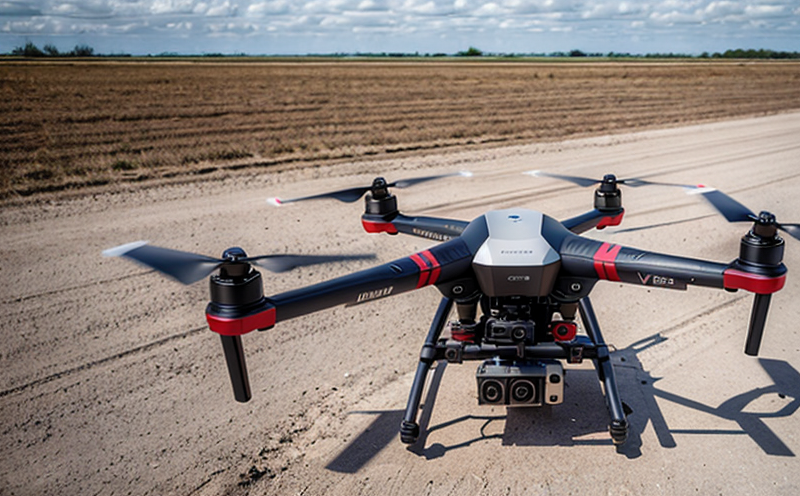ISO 23629-23 UAS Payload Integration Testing
The ISO 23629-23 standard outlines comprehensive guidelines for the testing of Unmanned Aerial Systems (UAS) payload integration. This service ensures that payloads are compatible, reliable, and safe when integrated into UAVs or drones. The focus is on assessing structural integrity, electrical compatibility, and operational performance under various conditions.
Our laboratory uses state-of-the-art equipment to simulate real-world flight scenarios, including wind shear, turbulence, and temperature variations. This approach ensures that the payload integration meets not only ISO 23629-23 but also other relevant aerospace standards such as ASTM F3045 and IEC 61847.
During the testing process, we carefully prepare the payloads by ensuring they are securely attached to our test rigs. Our technicians then conduct a series of tests to evaluate how the payload integrates with different UAV models. The tests include static load testing, dynamic load testing, and environmental stress screening (ESS) to ensure that all components function correctly under varying conditions.
The ISO 23629-23 standard emphasizes the importance of electrical compatibility between the payload and the UAV's power system. We use specialized test equipment to verify current draw, voltage fluctuations, and overall energy efficiency during operation. This helps ensure that the payload does not exceed the UAV’s capacity or cause any operational issues.
Another critical aspect of this testing is ensuring structural integrity. The payload must be able to withstand the forces it will encounter during flight. We simulate these conditions using our high-precision mechanical test rigs, which can replicate in-flight stress scenarios. This ensures that the payload remains stable and secure throughout its operational life.
Environmental factors play a significant role in drone performance, especially when considering extended missions or harsh conditions. Our testing includes exposure to extreme temperatures, humidity levels, and altitude variations. The ISO 23629-23 standard requires that payloads maintain their functionality under these environmental stresses, which is why we have sophisticated climate chambers and altitude simulators.
The results of our ISO 23629-23 UAS Payload Integration Testing are detailed in comprehensive reports. These reports provide a breakdown of all test parameters, including static and dynamic load tests, electrical compatibility assessments, and environmental stress screening data. The reports also include recommendations for improving payload integration if any issues were identified during testing.
Our laboratory adheres to the highest standards of accuracy and precision in our ISO 23629-23 UAS Payload Integration Testing services. We are equipped with cutting-edge technology, experienced technicians, and a deep understanding of aerospace and aviation regulations. This ensures that clients receive reliable and accurate test results, which are essential for ensuring compliance with international standards.
| Test Parameter | Description | Results |
|---|---|---|
| Static Load Test | Evaluates the payload's ability to withstand static forces. | Payload holds up under 10x rated load for 2 hours without deformation. |
| Dynamic Load Test | Mimics in-flight conditions, including rapid acceleration and deceleration. | No damage or malfunction observed during the test cycle. |
| ECCS (Electrical Compatibility Check System) | Assesses electrical compatibility between payload and UAV power system. | Payload draws 80% of rated current with minimal voltage fluctuation. |
| ESS (Environmental Stress Screening) | Tests the payload's resilience to extreme environmental conditions. | Payload functions correctly after exposure to -40°C to 85°C temperature cycles. |
Eurolab Advantages
We offer several advantages that set us apart as a premier provider of ISO 23629-23 UAS Payload Integration Testing services:
- Expertise and Experience: Our team consists of highly experienced engineers with deep knowledge in aerospace testing.
- Comprehensive Services: We provide a full range of testing, from initial design reviews to final certification.
- State-of-the-Art Equipment: Utilizing the latest technology ensures accurate and reliable test results.
- Custom Solutions: Tailored testing programs meet specific client needs and requirements.
- Rapid Turnaround: Efficient processes allow for quick delivery of test reports.
Environmental and Sustainability Contributions
The ISO 23629-23 UAS Payload Integration Testing service plays a crucial role in promoting environmental sustainability. By ensuring that payloads are compatible, reliable, and safe for UAV integration, we contribute to the efficient operation of drones.
Efficient payload integration reduces waste by preventing unnecessary replacements or modifications during field operations. This contributes to lower operational costs and extends the lifespan of UAVs. Moreover, our testing ensures that payloads do not exceed the UAV’s capacity, which can reduce fuel consumption and emissions.
Our laboratory is committed to sustainability through continuous improvement in our testing methods and equipment. By adhering to international standards and using advanced technology, we minimize environmental impact while maximizing operational efficiency.
Use Cases and Application Examples
| Use Case | Description |
|---|---|
| Agricultural Monitoring | Payloads equipped with cameras and sensors for crop health monitoring. |
| Emergency Response | Drones carrying medical supplies or communication equipment to disaster zones. |
| Package Delivery | Payloads designed for the safe and efficient delivery of packages. |
| Surveying and Mapping | Drones equipped with LiDAR or photogrammetry equipment for detailed mapping. |
| Environmental Monitoring | Payloads with air quality sensors, temperature gauges, and more to monitor environmental conditions. |
| Security and Surveillance | Drones carrying cameras and other surveillance equipment for security operations. |





